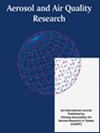Sources, Compositions, and Health Risks of PM2.5-bound PAHs at the Rural Area along with the “Coal to Gas” Law
IF 2.5
4区 环境科学与生态学
Q3 ENVIRONMENTAL SCIENCES
引用次数: 0
Abstract
The “Coal to Gas” (CTG) policy in north China markedly altered the characteristics of polycyclic aromatic hydrocarbons (PAHs) in PM 2.5 . Existing researches about CTG impacts on components, sources, and health risks of PM 2.5 -bound PAHs mainly focused on metropolitan area, whereas they were lacking in rural area of north China. Here, we deployed an intensive observation in winter of 2020 at a rural site in the central area of the Beijing-Tianjin-Hebei (BTH) region. A positive matrix factorization (PMF) model and an incremental lifetime cancer risk (ILCR) model were utilized to examine the PAH sources and health risks. Higher daily average PM 2.5 of 81.5 µ g m –3 in the sampling period than 75 µ g m –3 of the National Air Quality Standard Grade II indicated the air pollution in rural area was still serious. The total PAHs increased obviously from diurnal 86.2 ng m –3 to nocturnal 151 ng m –3 because of the nocturnal high intensity of heating, with the increases of 20.7%, 85.5%, and 76.3% for low, medium, and high molecular weight PAHs, respectively. Vehicular exhaust (VE), coal burning (CB), industrial source (IS), biomass burning (BB), and oil spill and leakages (OSL) were the main PAH contributors, with the average daily contributions of 32.7%, 21.5%, 18.3%, 15.9%, and 11.6%, respectively. Lower CC contribution of 27.6% in winter of 2020 than 27.6% in winter of 2019 indicated the positive role of CTG policy. However, the nocturnal CC fraction increased by 680% compared with the diurnal value, and CC had become the largest contributor in the nighttime. BB contribution was up to 18.3%, evidencing that biomass utility should be managed in term of the biomass burning was prohibited in BTH rural area. Moreover, the nocturnal average BaPeq equivalent concentration exhibited higher levels than those in the daytime. The nocturnal ILCR values of adults and children was 9.35 × 10 –6 and 2.66 × 10 –6 , exceeding the acceptable threshold, suggesting there was a potential carcinogenic risk.农村地区pm2.5结合多环芳烃的来源、成分和健康风险与“煤改气”法
煤改气政策显著改变了华北地区pm2.5中多环芳烃(PAHs)的特征。现有的CTG对pm2.5结合多环芳烃组分、来源和健康风险的影响研究主要集中在城市地区,而对华北农村地区的研究较少。在此,我们于2020年冬季在京津冀中部地区的一个农村站点进行了密集观测。采用正矩阵分解(PMF)模型和终生癌症风险增量(ILCR)模型检测多环芳烃来源和健康风险。采样期内日均pm2.5为81.5µg m -3,高于国家空气质量二级标准75µg m -3,说明农村地区空气污染依然严重。由于夜间高强度的加热,多环芳烃总量从白天的86.2 ng m -3明显增加到夜间的151 ng m -3,低、中、高分子量多环芳烃总量分别增加了20.7%、85.5%和76.3%。汽车尾气(VE)、燃煤(CB)、工业源(IS)、生物质燃烧(BB)和溢油泄漏(OSL)是多环芳烃的主要贡献源,日均贡献分别为32.7%、21.5%、18.3%、15.9%和11.6%。2020年冬季的碳排放贡献率为27.6%,低于2019年冬季的27.6%,表明CTG政策发挥了积极作用。然而,夜间CC比白天增加了680%,夜间CC已成为最大的贡献者。BB贡献度高达18.3%,说明北京市农村禁止生物质燃烧,应当对生物质利用进行管理。夜间平均BaPeq当量浓度高于白天。成人和儿童夜间ILCR分别为9.35 × 10 -6和2.66 × 10 -6,均超过可接受阈值,存在潜在的致癌风险。
本文章由计算机程序翻译,如有差异,请以英文原文为准。
求助全文
约1分钟内获得全文
求助全文
来源期刊

Aerosol and Air Quality Research
ENVIRONMENTAL SCIENCES-
CiteScore
8.30
自引率
10.00%
发文量
163
审稿时长
3 months
期刊介绍:
The international journal of Aerosol and Air Quality Research (AAQR) covers all aspects of aerosol science and technology, atmospheric science and air quality related issues. It encompasses a multi-disciplinary field, including:
- Aerosol, air quality, atmospheric chemistry and global change;
- Air toxics (hazardous air pollutants (HAPs), persistent organic pollutants (POPs)) - Sources, control, transport and fate, human exposure;
- Nanoparticle and nanotechnology;
- Sources, combustion, thermal decomposition, emission, properties, behavior, formation, transport, deposition, measurement and analysis;
- Effects on the environments;
- Air quality and human health;
- Bioaerosols;
- Indoor air quality;
- Energy and air pollution;
- Pollution control technologies;
- Invention and improvement of sampling instruments and technologies;
- Optical/radiative properties and remote sensing;
- Carbon dioxide emission, capture, storage and utilization; novel methods for the reduction of carbon dioxide emission;
- Other topics related to aerosol and air quality.
 求助内容:
求助内容: 应助结果提醒方式:
应助结果提醒方式:


